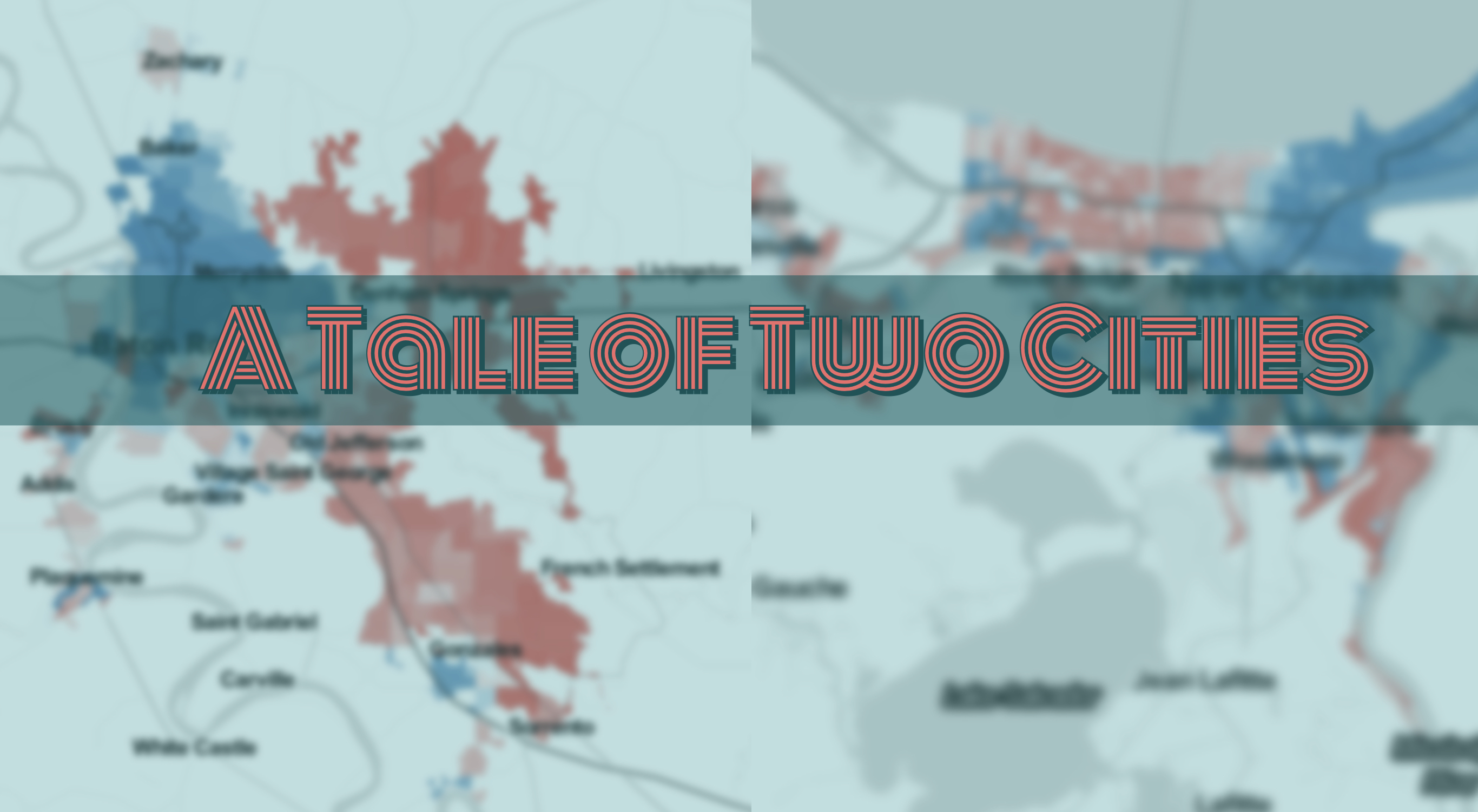According to analysis published yesterday by FiveThirtyEight, three of the nation’s five most politically-polarized cities are in Louisiana (New Orleans #2, Baton Rouge #3, and Shreveport #5), a reflection of the state’s growing partisan divide and also a testament to the multi-generational government subsidization of “white flight” infrastructure and the continued development of the kind of densely-packed and predominately African American public housing projects that have come to characterize inner-cities across the country.
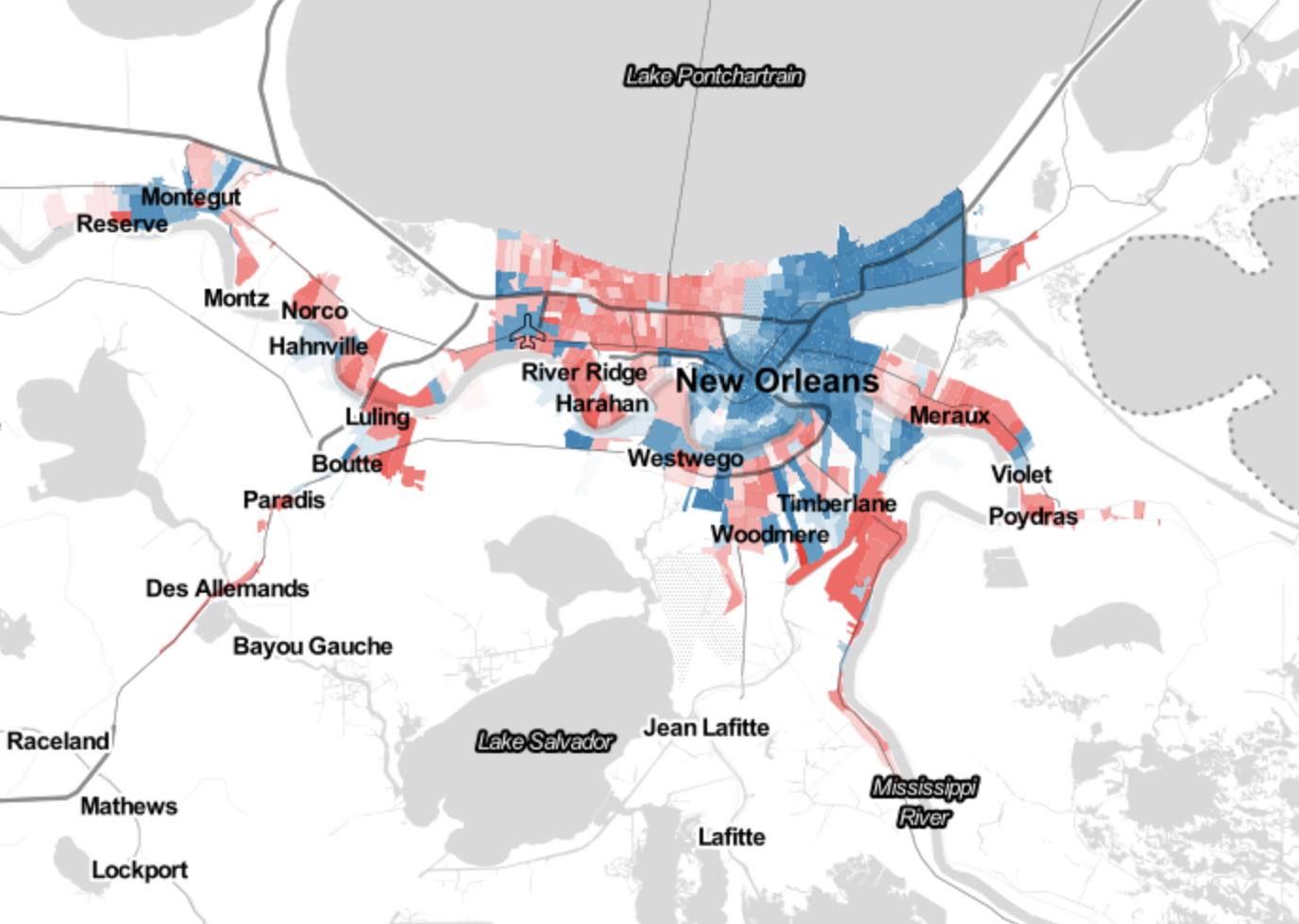
Lafayette narrowly avoided the top ten, placing 11th on the list, directly behind the Greater New York City area (the only non-Southern city in the top ten).
Jackson, Mississippi ranked first, and Birmingham, Alabama placed in fourth.
All of the cities in the top five are in the Deep South, led by African American mayors, and surrounded by rings of low-density and overwhelmingly white suburbs. (In defining cities, the analysis relies on the same framework used by the U.S. Census Bureau).
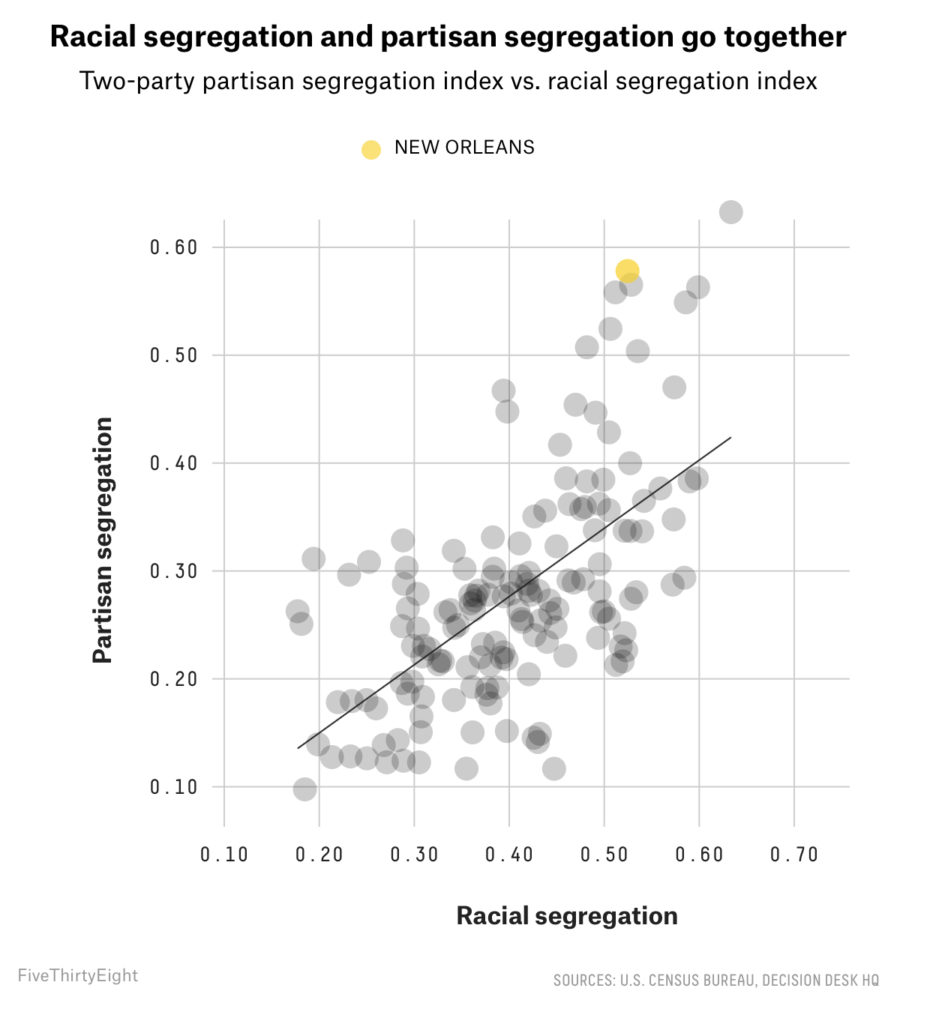
At first glance, it may be easy to attribute partisan polarization to racial divisions (after all, more than 80% of African American registered voters are Democrats, and during the 2016 presidential election, 89% of African American voters supported Hillary Clinton, while 70% of white voters supported Donald Trump), but the truth is slightly more nuanced.
“An obvious trend jumps out when you look at the most politically segregated cities: They’re also the cities with some of the highest proportions of black residents,” FiveThirtyEight’s Rachel Dottie explains. “The persistence of racial segregation in American cities continues to define those cities’ politics.”
To understand how these cities became both politically and racially segregated, you must also understand how they were (and are still being) developed.
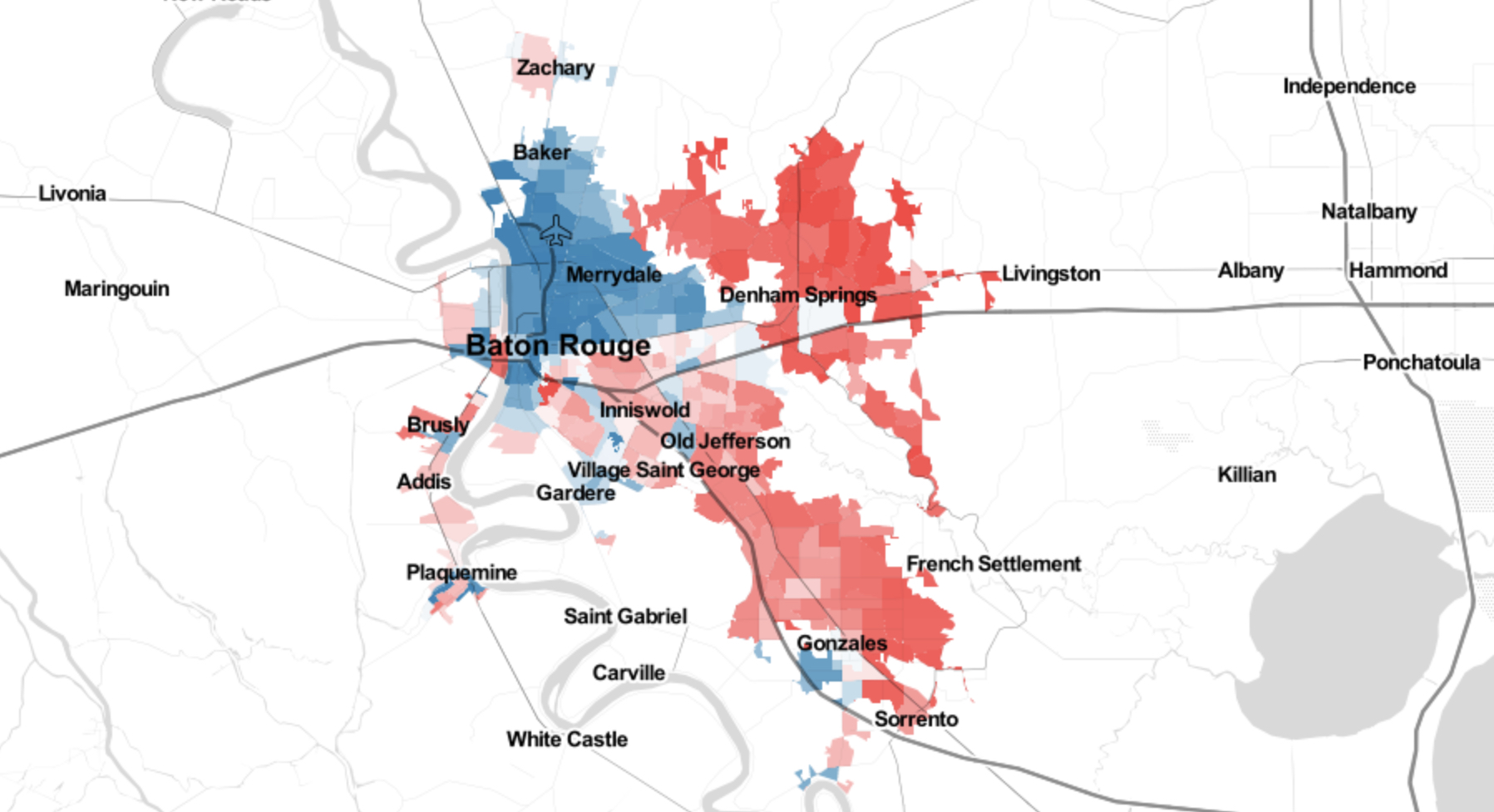
Recasting St. George:
This fall, as a result of an expensive and protracted petition initiative, voters in a majority white, 60-square-mile area of East Baton Rouge Parish will decide whether to incorporate the proposed city of St. George, Louisiana. In 2015, a similar initiative fell 71 names short of the number necessary to send the proposal to voters, and despite organizers’ insistence to the contrary, the campaign was widely perceived as racist.
East Baton Rouge Parish, like Lafayette Parish, is governed by a convoluted “consolidated” body of both city and parish elected officials and led by an awkwardly-titled “Mayor-President.” While intended to maximize a region’s access to federal and state funding and streamline services, the consolidated governments in both Baton Rouge and Lafayette have sometimes exacerbated political, socioeconomic, and racial tensions.
The proposal to incorporate St. George, for example, was initially conceived as a way to create a new school district, effectively steering tens of millions of dollars away from the existing majority African American, financially-scrapped public school system in order to create a majority white and significantly wealthier system.
Although this year’s proposal is 15 square miles and 20,000 people smaller than the effort that failed four years ago, the new city would immediately become the fifth-largest in Louisiana, dethroning Lake Charles. And while the redrawn borders may have improved its chances at the ballot box, it is difficult to ignore the decision to exclude majority African American neighborhoods that had once been included.
“They don’t want African Americans in this city,” attorney Mary Olive Pierson told The Advocate last year. “That’s what it looks like to me.” Pierson had previously represented the city of Baton Rouge when it opposed the 2015 proposal.
Notably, the real St. George was an immigrant who, as legend has it, killed a dragon in order to save a city. He is now considered a symbol of multiculturalism, revered by both Muslims and Christians alike, the patron saint of both England and Ethiopia.
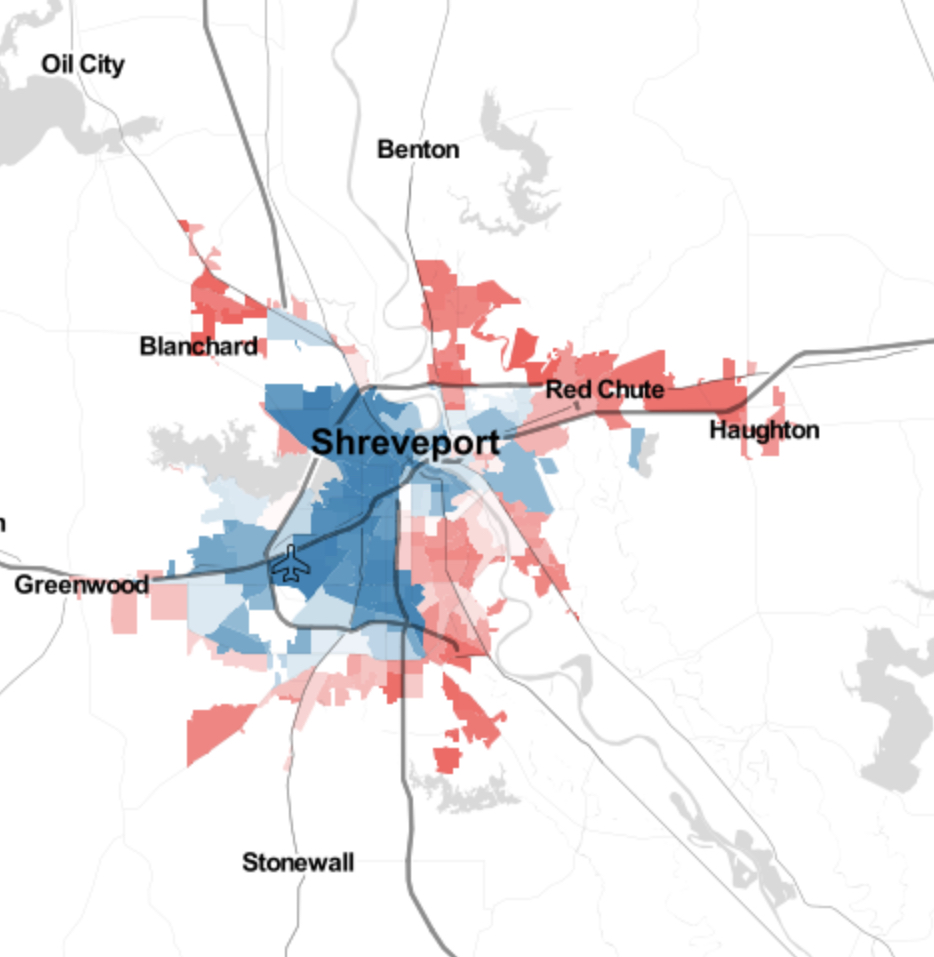

Sprawling Into Silos:
The footprints of Louisiana’s major urban areas began a dramatic retransformation in the late 1960s, which, not coincidentally, was also when the state’s public schools were finally being forced to comply with court-ordered integration (and when a substantial number of Louisiana’s private schools were founded).
It was also the same time during which the country was being reshaped by the most significant and ambitious infrastructure project in its history: The construction of the Dwight D. Eisenhower National System of Interstate and Defense Highways, a $521 billion, 48,191 mile-long network of concrete that would fundamentally change the way Americans understood their country and their own hometowns.
In 1950, the population of Jefferson Parish in suburban New Orleans was slightly more than 100,000; by 1980, it had more than quadrupled. During those intervening decades, specifically between August of 1957 and May of 1975, all 274 miles of Louisiana’s stretch of Interstate 10 had been constructed, with most of it completed in the late 1960s. It is impossible to imagine Jefferson Parish or, for that matter, the majority of today’s Baton Rouge without I-10.
All of that concrete paved the way for vast new neighborhoods designed and marketed to entice white middle-class families out of cities and into the suburbs.
Even cities and towns where the interstate would not arrive for decades found themselves swept into the trend of sprawl-development.
In 1960, Alexandria, Louisiana, for example, was approximately nine square miles with a population of around 45,000 people. By 1980, the city had tripled in geographic size, up to 27 square miles, while its population remained stagnant. Interstate 49 would not open until 1996, cutting through the center of the city’s downtown and, in the process, requiring the demolition of nearly 90% of its inventory of historic properties. Yet Alexandria did not sprawl because of the interstate but because of larger political, cultural, and behavioral forces that the interstate engendered.
I’m familiar with Alexandria not only because I was born there, but also because my paternal grandfather along with his uncle and, to a certain extent, my late father were partly responsible for developing the bulk of the city’s residential sprawl. A decade ago, when I worked as an assistant to the mayor, I found myself frequently researching, writing about, and discussing the ways in which the emphasis on sprawl resulted in a concomitant public disinvestment from the most marginalized and vulnerable neighborhoods.
Alexandria is not large enough to earn a ranking on FiveThirtyEight’s list, but I suspect that if it were, it’d place alongside New Orleans, Baton Rouge, Shreveport, and Lafayette. Its story is not unusual at all. To be sure, all of these cities had always been racially divided. Before there was the interstate, there was the railroad, which in countless cities across the country and especially in the Deep South became synonymous with the line of demarcation between white neighborhoods and black neighborhoods. In many cases, the interstate traces alongside the same line, as it does in Alexandria and in much of Lafayette.
In other words, the interstate didn’t create the kind of racial segregation that characterize Louisiana’s larger cities, but it most certainly exacerbated it. There is already ample scholarship on how sprawl was typically a publicly-subsidized scheme designed to facilitate the mass out-migration of white, middle-class families from increasingly diverse, urban inner-cities, but the fact deserves emphasis in Louisiana, where the urban/rural divide is so profound and where white conservatives, in particular, are often led to believe a fantasy in which their suburban paradises were purely driven by the free market and the inner-cities were built by Uncle Sam.
Taxpayers financed nearly the entire operation, and to a large extent, they still do. This isn’t a radical opinion, nor is it a rejection of free market principles. It is merely a basic statement of fact. In rural communities, the USDA is often the only reason families can purchase a home, and in big cities, public housing projects are a way for wealthy private developers to become even wealthier.
“There is still the question of why these things persist now, 51 years after the Fair Housing Act,” Keeanga-Yamahtta Taylor, a professor of African American Studies at Princeton University, told FiveThirtyEight. “Part of the reason is the federal government continues to connect its housing policies to private-sector housing producers. The programs, to the extent that they do exist, are yoked to the private sector, which not only has a history steeped in racial discrimination but has made contemporary practices that are connected to that. This is not ancient history.”
She is right.
In Louisiana, the government throws billions of dollars away every year in order to subsidize some of the world’s most profitable corporations, and conservative lawmakers, who usually style themselves as champions of local control, typically oppose measures that could challenge those subsidies, whether it’s related to approval of tax exemptions or the establishment of a for-profit charter school. In recent years, lawmakers have found ways to use a taxing mechanism designed to combat blight into a scheme to underwrite expensive hotel developments and massive retail centers in the middle of nowhere but still directly off of the interstate.
While Louisiana should rightfully celebrate its diversity, there is a real danger when our communities become so dramatically and fiercely polarized. Local governments become dysfunctional, and public service becomes a career only attainable by those who traffic in division. People lose perspective; they lose a collective sense of pride and decency; they manage to never learn the definition of the word “neighbor.” They forget that schools teach real children and hospitals treat real patients.
We should be legitimately concerned about Louisiana’s strikingly polarized cities, because instead of signifying something positive about our future, it only serves as a reminder of a past that remains very much present.
Today, as the suburbs contract and as cities continue to be rediscovered and reimagined, we must also guard ourselves against a second wave of displacement. There is both a tension and a balance between affordability and livability, but there is no public good, for example, in allowing a small handful of wealthy investors the opportunity to threaten entire communities by transforming affordable housing into expensive short-term rentals or in tearing down a vast swath of an inner-city to make room for an interstate overpass.
That’s Right, You’re Not From Texas. But Texas Wants You Anyway.
There is one other thing Louisianians should especially consider, because for the past two or three decades, it has been a favorite go-to talking point used by the state’s wealthiest corporations and industries.
Contrary to what many of us have been told, no, young people are not abandoning Louisiana for Texas because the Lone Star State doesn’t have a state income tax. (That may be why Californians are moving in droves to Austin and Dallas before realizing the state’s exorbitant property taxes).
I have spent roughly half of the past twenty years living in Texas and the other half living in Louisiana, so I speak from experience: We’re not losing young professionals to Texas because of taxes or because anyone is spooked by lawsuits against oil and gas companies or because their state government runs a smoother operation. That’s all ludicrous (and Texas’ state government is measurably more dysfunctional than Louisiana’s).
We’re losing people to Texas because Houston is the most diverse city in the entire country, because Austin is weird and vibrant, and because Dallas is bold and vastly more cosmopolitan than it likes to let on. During the past nine years, Dallas’ population has grown by more than a million; currently, on average, every single day, 246 people move to Dallas, more than any other city in the nation. Five years ago, that distinction belonged to Houston, when 269 new residents showed up every day. Austin may be a smaller city, but throughout the past decade, it has routinely attracted a daily supply of more than 100 new weirdos.
There is really no grand mystery: Innovative, ambitious, and culturally diverse cities are the engine fueling Texas; the state already figured out the idiocy of tying its economy to the whims of the global price of a barrel of oil. And while, yes, the state government is still largely controlled by cartoon cowboy conservatives, cities shape public policy much more frequently and usually more profoundly than the legislature, which meets only once every two years.
If you traffic in bigotry- if your politics is largely a mixture of anti-immigrant bluster and rants about why the Black Lives Matter movement is unfair to white people- I have some bad news: You don’t have any shot at governing a booming, entrepreneurial, diverse, and modern American city like Houston or Austin. Try the suburbs instead. Heck, even George W. Bush is represented in Congress by an African American Democrat.
So, yes, there are several lessons Texas can teach Louisiana about how to future-proof its workforce and celebrate inclusion over polarization. Successful cities don’t have the time or the inclination to allow a group of homophobes to turn a reading event at a local library into a moral crusade. When Dallas decided to remove their lawn ornament to Robert E. Lee (much to the credit, it should be said, to the example set by former New Orleans Mayor Mitch Landrieu), they didn’t feel compelled to coddle the delicate feelings of the city’s white supremacists. The city council passed an emergency ordinance, and crews began prepping its removal almost immediately. When an opponent filed a temporary restraining order, they were able to get the complaint dismissed within a day. Then, they showed up with a flatbed and a crane and hauled the stupid thing away, permanently.
Sure, ugliness sometimes rears its head. Voters in Houston, for example, rejected an anti-discrimination ordinance a few years ago, the consequence of a brazenly false and hateful campaign that suggested the law would result in an increase in child abuse and sexual assault. But it should be noted that, at the time, Houston’s mayor was Annise Parker, an openly gay woman who had been elected to three consecutive terms in office before term limits made her ineligible for a fourth term.
The state isn’t immune to political corruption either. A couple of years ago, members of the Dallas Independent School District were ensnared in one of the largest public bribery scandals in the nation’s history. But in fairness, the whole thing was orchestrated by a Louisiana businessman. Last week, he was sentenced to seven years in prison, and no one in Louisiana bothered to notice or to care.
Texas is not perfect, far from it, in fact, but there is one, simple thing Louisiana can learn from its neighbor, best articulated by Lyle Lovett. Quoting:
See I was born and raised in Texas
And it means so much to me
Though my girl comes from down in Georgia (clearly, Julia Roberts)
We were up in Tennessee
And as we were driving down the highway
She asked me baby what’s so great
How come you’re always going on
About your lone star state
I said that’s right you’re not from Texas
That’s right you’re not from Texas
That’s right you’re not from texas
But Texas wants you anyway

